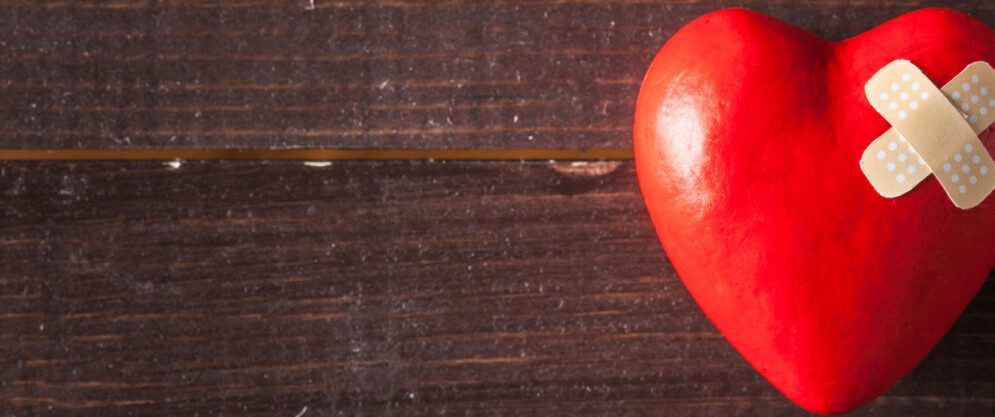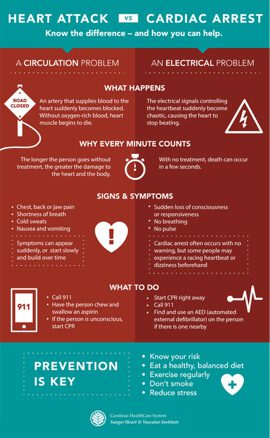
What is Cardiac Arrest?
Sudden cardiac arrest occurs when your heart stops suddenly, and without warning.
The heart has its own electrical system which pumps blood around the body and delivers essential oxygen and nutrients to the cells. When there is a problem with this system, it disrupts the heart’s pumping action, meaning that the brain is starved of oxygen. When this happens, the person stops breathing, loses consciousness and death can occur in minutes without fast and appropriate medical care.
There are generally no warning signs of a cardiac arrest. In some instances, a person may experience symptoms such as dizziness, chest pain, blackouts and shortness of breath. However, in the majority of cases, symptoms are immediate and death can occur within minutes.
If someone is in cardiac arrest:
- They collapse suddenly and lose consciousness.
- They are unresponsive and have no pulse.
- They won’t be breathing.
A cardiac arrest is a medical emergency. Death or brain damage can occur within 4 to 6 minutes. If you witness a cardiac arrest:
- Check for a response – gently shake the person’s shoulders and ask loudly ‘are you alright?’.
- Shout for help – ask someone for an automated external defibrillator (AED). If you can’t find anyone to help, DO NOT DELAY – call 999 or 112 immediately and follow the call-taker’s instructions before you start CPR.
- Check for normal breathing – look, listen and feel for no more than 10 seconds.
- If breathing is normal, put them in the recovery position and call 999 or 112, if you haven’t done already.
- If breathing isn’t normal, protect their airway. Place one hand on the person’s forehead, gently tilt their head back, then lift their chin using two fingers of your other hand under their chin.
- Start CPR:
- Kneel next to the person.
- Place the heel of one hand in the centre of their chest. Place your other hand on top of the first. Interlock your fingers.
- With straight arms, use the heel of your hand to push the breastbone down between 5-6 cm firmly and smoothly.
- Do this at a rate of 100-120 chest compressions per minute – that’s around 2 per second.
- Continue CPR until a portable AED arrives or until medical personnel can take over.
- Use an AED to shock the person’s heart back to life.
People often think that a cardiac arrest and a heart attack are the same thing, but this isn’t true.


Cardiac arrest is most commonly caused by a life-threatening, abnormal heart rhythm called ventricular fibrillation (VF). This occurs when the electrical signals that control the lower chambers of the heart (the ventricles) become chaotic and disorganised. These signals cause the ventricles to quiver or ‘fibrillate’ instead of pumping blood around the body.
There are many risk factors that can lead to sudden cardiac arrest. Some of these are related to specific heart conditions such as:
- Previous heart attack or cardiac arrest.
- Coronary heart disease.
- Enlarged heart (cardiomyopathy).
- Heart valve disease.
- Inherited (congenital) heart disease.
- Problems with the heart’s electrical system.
Cardiac arrest can also happen to people who do not know they have a heart problem and sometimes, to people who do not have heart disease. Other factors that can put you at risk of cardiac arrest are:
- Family history of coronary heart disease, heart attack or heart failure.
- Age – the incidence of sudden cardiac arrest increases with age.
- Being male – men are two to three times more likely to experience sudden cardiac arrest.
- Using illegal drugs or a drug overdose.
- Smoking and excessive alcohol consumption.
- High blood pressure and high blood cholesterol.
- A sedentary lifestyle.
If you have survived a sudden cardiac arrest, your doctor will investigate the reasons as to why this occurred in the first place. There are a number of things that people can do to decrease the likelihood of experiencing sudden cardiac arrest including:
- Control abnormal heart rhythms: Your doctor may recommend anti-arrhythmia medication or an implantable cardioverter defibrillator (ICD) that monitors the rhythm of your heartbeat and delivers a series of electrical impulses if the heart’s own electrical system malfunctions.
- Healthy Lifestyle: Following the medical advice you receive, having regular check-ups with your doctor as well as making positive lifestyle changes can reduce your risk of sudden cardiac arrest. See Croí’s advice for Living a Healthy Life here.
Early intervention can increase the chance of a person surviving a cardiac arrest by more than 50%. Find out where your nearest AED is located. If there isn’t any, encourage your community group, school or workplace to support the installation of AEDs. If you would like to learn CPR, contact Croí to enrol in a cardiac first responder course.
